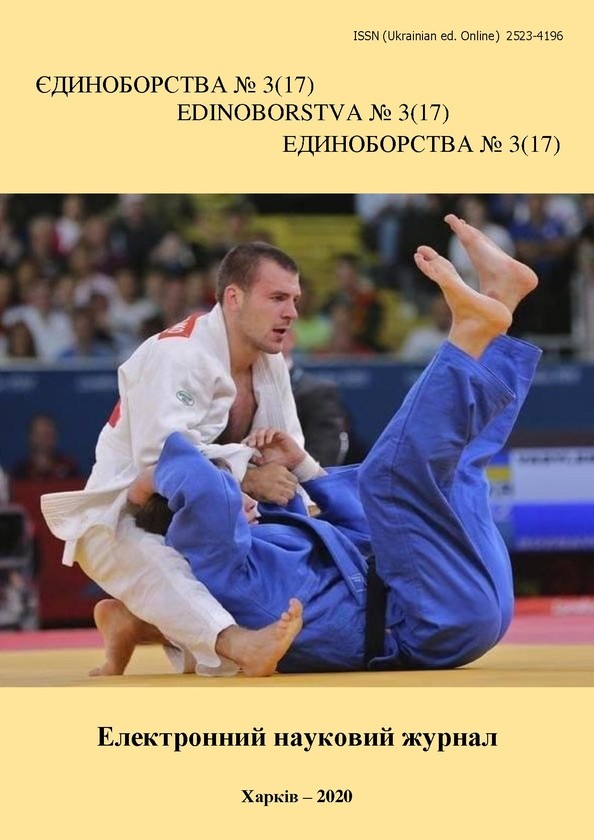Investigation of the level of anxiety and sensorimotor reactions of taekwondo juniors
DOI:
https://doi.org/10.15391/ed.2020-3.07Keywords:
anxiety, mental state, sensomotory reaction, single combats, relationship, taekwon-do, athletesAbstract
Purpose: to determine the peculiarities of the manifestation of anxiety and sensomotory reactions of athletes juniors in taekwon-do. Material and methods. The scientific study was attended by athletes (15,3 ±0,14 years) of the sports club «White Bear» in the number of 17 athletes. Spielberger-Hanin methodology was used to differential estimate the level of anxiety. The method is an informative way of self-evaluating the level of anxiety at a given moment (reactive anxiety, as a condition) and personal anxiety (as a steady human characteristic). An instrumental method was used to evaluate sensomotor reactions. Specialized test programs for tablets: determining the response of choice; evaluation of short-term visual memory. Results: study of interrelationships between manifestation of response of choice and short-term visual memory with level of manifestation of situational anxiety in athletes taking part in study, showed as far as single fighters own ability to analyze the mental state. Analysis of these relationships at the first test shows that not all athletes can accurately assess their personal level of situational anxiety. Thus, for such an indicator as the percentage of precise clicks, the statistically significant relationship was r=0,18; For visual response time to visual signals when measuring short-term visual memory r=0,44; For the selection reaction time r=0,18. The results of the second test show that there are statistically significant relationships between the level of manifestation of situational anxiety and psychophysiological indicators. So, for the percentage of exact presses r=0,66; For visual response time to visual signals when measuring short-term visual memory r=0,76; For the selection reaction time r=0,68. Conclusions. Research on the manifestation of anxiety is of great importance in terms of optimizing the psychological training of athletes juniors in taekwon-do. Indicators of personal, situational anxiety and indicators of sensomotor reactions are determined. Thus, the level of personal anxiety of athletes juniors in taekwon-do amounted to 32,4±9,42 points, the level of reactive anxiety 33,9±6,93 points. Estimation of the level of short-term visual memory and the response of selection of athletes juniors in taekwon-do at the first and second tests showed no statistically significant differences between the indicators (p>0,05). On the basis of the analysis of the relationships between the analysed indicators, it was determined that the use of simultaneous methods o assessing the level of anxiety and sensomotor reactions allows to obtain objective data on the characteristic of the situational mental state of athlete.
References
Алексеев, А. Ф. (2010). Моделирование тренировочных заданий в единоборствах. Физическое воспитание студентов, 3-7.
Арзютов, Г. Н. (1999). Многолетняя подготовка в спортивных единоборствах. НПУ им. М. П. Драгоманова, Киев.
Ашанин, В. С, & Романенко, В. В. (2015). Использование компьютерных технологий при оценке сенсомоторных реакций в единоборствах. Слобожанский науково-спортивнии сбірник, No4 (48), 15-18.
Волков, И. П. (2002). Практикум по спортивной психологии. СПб.: Питер.
Воронова, В. И., Федорчук, С. В., Тукаев, С.В., Лысенко, Е. Н., & Шинкарук О. А. (2017). Психофизиологическое состояние спортсменов с разным уровнем личностной и ситуативной тривожности в сложнокоординационных видах спорта. Спортивна медицина і фізична реабілітація, № 1, 26-32.
Горностай, П. П. & Титаренко, Т. М. (2001). Психологія особистості: Словник довідник. Рута, Київ.
Ильин, Е. П. (2012). Психология спорта. СПб.: Питер.
Осадець, М. М. (2014). Психологічна підготовка особистості в спорті. Наукова педагогична думка, науковий журнал, №4, 155-157.
Павлик, О. М., & Вакуленко, Д. О. (2011). Особенности тривожности у эмоционально устойчивых и неустойчивых кикбоксеров. Слобожанський науково-спортивний вісник, №4, 266-268.
Прихожан, А. М. (2007). Психология тривожности. СПб.: Питер.
Ровный, А. С., & Романенко В. В. (2016). Модельные характеристики сенсомоторных реакций и специфических восприятий единоборцев высокой квалификации. Единоборства, №1, 54-57.
Романенко, В. В. (2017). Современные компьютерные технологии в профессиональной деятельности единоборцев (методические рекомендации). ХГАФК, Харьков.
Романенко, В. В., Голоха, В. Л., & Веретельникова, Н. А. (2018). Оценка и анализ подготовленности квалифицированных тхеквондистов. Единоборства, No 1, 58-69.
Романенко, В. В., & Ровный, А. С. (2016). Модельные характеристики сенсомоторных реакций и специфических восприятий единоборцев высокой квалификации. Единоборства No1, 54-57.
Романенко, В. В, & Голоха, В. Л., & Веретельникова, Н. А. (2018). Особенности проявления кратковременной зрительной памяти у единоборцев ХГАФК. Единоборства, No 4, 33-41.
Рудик, П. А. (2010). Психологические аспекты спор¬тивной деятельности. Психология и современный спорт. 101-105.
Ханин, Ю. Л. (1991). Межличностная и внутригрупповая тревога в условиях значимой совместной деятельности. Вопр. Психологии, № 9, 56–64.
Ханин, Ю. Л. (1976). Краткое руководство к применению шкалы реактивной и личностной тривожности Ч. Д. Спилбергера. Л. ЛНИИТЕК, 56-61.
Iermakov, S., Podrigalo, L., Romanenko, V., Tropin, Y., Boychenko, N. & Rovnaya, O. (2016). Psycho-physiological features of sportsmen in impact and throwing martial arts. Journal of Physical Education and Sport, Vol. 16(2), 433-441.
Rovnaya, О, Volodchenko, О., Podrigalo, L., Aghyppo, О., & Romanenko, V. (2018). Comparative Analysis of a functional state of martial arts athletes. Journal of Physical Education and Sport, T17, No 3, p 2142-2147.













